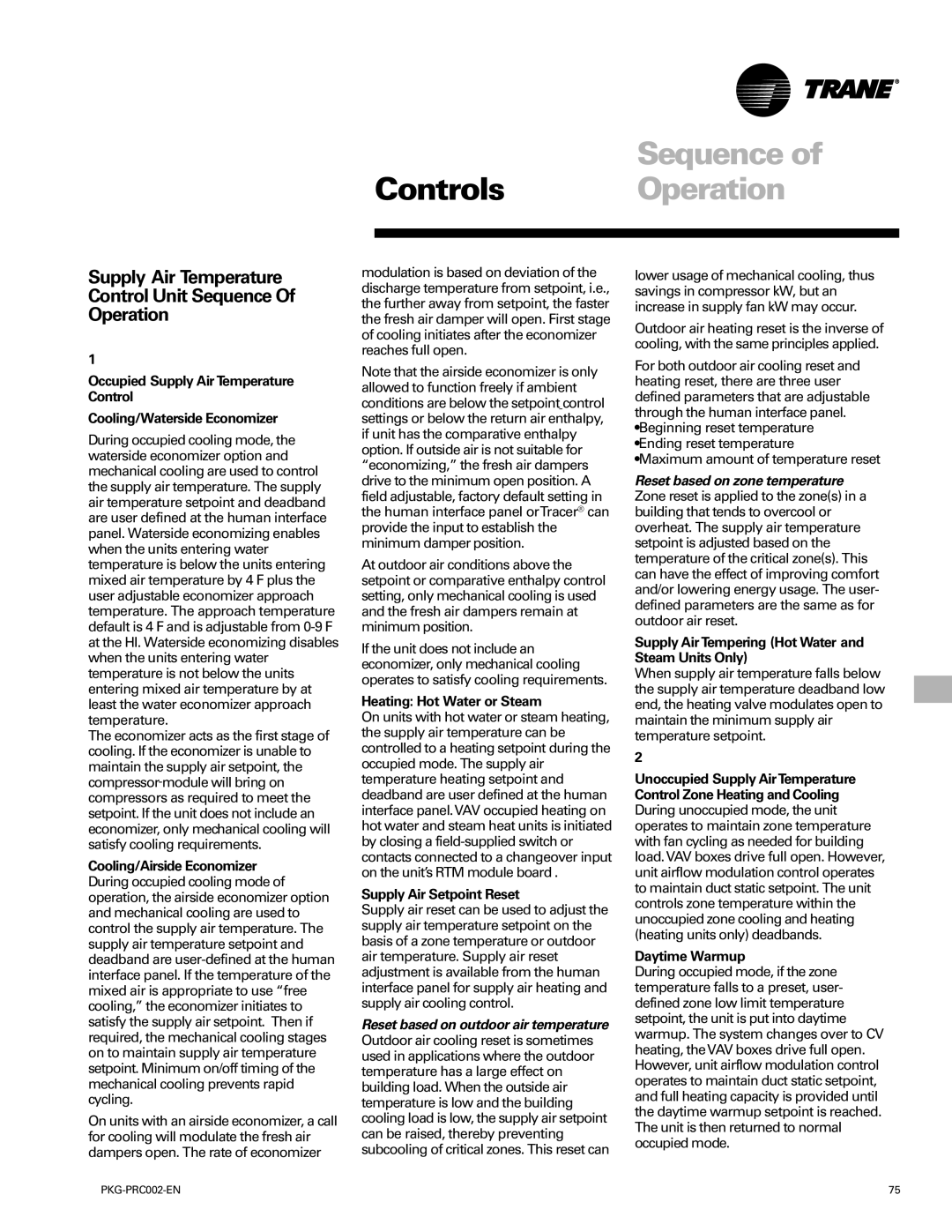Supply Air Temperature
Control Unit Sequence Of
Operation
1
Occupied Supply Air Temperature Control
Cooling/Waterside Economizer
During occupied cooling mode, the waterside economizer option and mechanical cooling are used to control the supply air temperature. The supply air temperature setpoint and deadband are user defined at the human interface panel. Waterside economizing enables when the units entering water temperature is below the units entering mixed air temperature by 4 F plus the user adjustable economizer approach temperature. The approach temperature default is 4 F and is adjustable from 0-9 F at the HI. Waterside economizing disables when the units entering water temperature is not below the units entering mixed air temperature by at least the water economizer approach temperature.
The economizer acts as the first stage of cooling. If the economizer is unable to maintain the supply air setpoint, the compressor module will bring on compressors as required to meet the setpoint. If the unit does not include an economizer, only mechanical cooling will satisfy cooling requirements.
Cooling/Airside Economizer During occupied cooling mode of operation, the airside economizer option and mechanical cooling are used to control the supply air temperature. The supply air temperature setpoint and deadband are user-defined at the human interface panel. If the temperature of the mixed air is appropriate to use “free cooling,” the economizer initiates to satisfy the supply air setpoint. Then if required, the mechanical cooling stages on to maintain supply air temperature setpoint. Minimum on/off timing of the mechanical cooling prevents rapid cycling.
On units with an airside economizer, a call for cooling will modulate the fresh air dampers open. The rate of economizer
modulation is based on deviation of the discharge temperature from setpoint, i.e., the further away from setpoint, the faster the fresh air damper will open. First stage of cooling initiates after the economizer reaches full open.
Note that the airside economizer is only allowed to function freely if ambient conditions are below the setpoint control settings or below the return air enthalpy, if unit has the comparative enthalpy option. If outside air is not suitable for “economizing,” the fresh air dampers drive to the minimum open position. A field adjustable, factory default setting in the human interface panel orTracer® can provide the input to establish the minimum damper position.
At outdoor air conditions above the setpoint or comparative enthalpy control setting, only mechanical cooling is used and the fresh air dampers remain at minimum position.
If the unit does not include an economizer, only mechanical cooling operates to satisfy cooling requirements.
Heating: Hot Water or Steam
On units with hot water or steam heating, the supply air temperature can be controlled to a heating setpoint during the occupied mode. The supply air temperature heating setpoint and deadband are user defined at the human interface panel.VAV occupied heating on hot water and steam heat units is initiated by closing a field-supplied switch or contacts connected to a changeover input on the unit’s RTM module board .
Supply Air Setpoint Reset
Supply air reset can be used to adjust the supply air temperature setpoint on the basis of a zone temperature or outdoor air temperature. Supply air reset adjustment is available from the human interface panel for supply air heating and supply air cooling control.
Reset based on outdoor air temperature Outdoor air cooling reset is sometimes used in applications where the outdoor temperature has a large effect on building load. When the outside air temperature is low and the building cooling load is low, the supply air setpoint can be raised, thereby preventing subcooling of critical zones. This reset can
lower usage of mechanical cooling, thus savings in compressor kW, but an increase in supply fan kW may occur.
Outdoor air heating reset is the inverse of cooling, with the same principles applied.
For both outdoor air cooling reset and heating reset, there are three user defined parameters that are adjustable through the human interface panel. •Beginning reset temperature •Ending reset temperature •Maximum amount of temperature reset
Reset based on zone temperature Zone reset is applied to the zone(s) in a building that tends to overcool or overheat. The supply air temperature setpoint is adjusted based on the temperature of the critical zone(s). This can have the effect of improving comfort and/or lowering energy usage. The user- defined parameters are the same as for outdoor air reset.
Supply Air Tempering (Hot Water and Steam Units Only)
When supply air temperature falls below the supply air temperature deadband low end, the heating valve modulates open to maintain the minimum supply air temperature setpoint.
2
Unoccupied Supply AirTemperature Control Zone Heating and Cooling During unoccupied mode, the unit operates to maintain zone temperature with fan cycling as needed for building load.VAV boxes drive full open. However, unit airflow modulation control operates to maintain duct static setpoint. The unit controls zone temperature within the unoccupied zone cooling and heating (heating units only) deadbands.
Daytime Warmup
During occupied mode, if the zone temperature falls to a preset, user- defined zone low limit temperature setpoint, the unit is put into daytime warmup. The system changes over to CV heating, theVAV boxes drive full open. However, unit airflow modulation control operates to maintain duct static setpoint, and full heating capacity is provided until the daytime warmup setpoint is reached. The unit is then returned to normal occupied mode.

